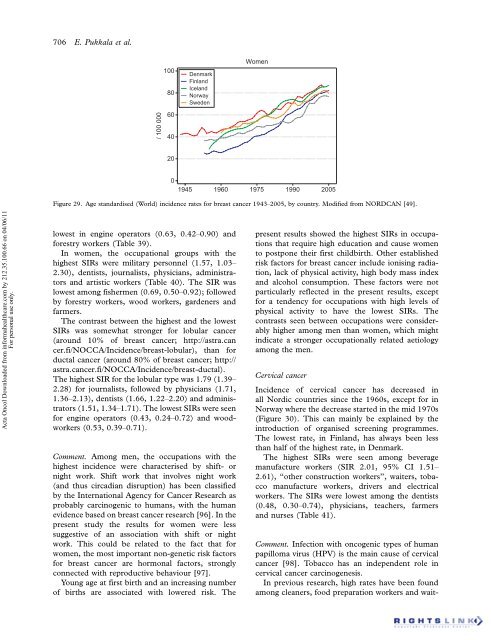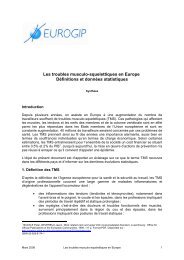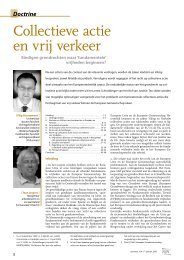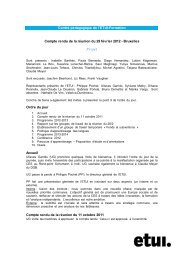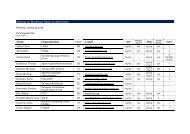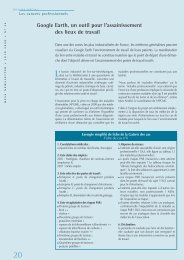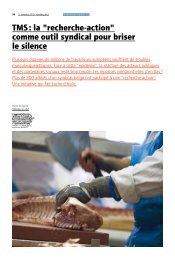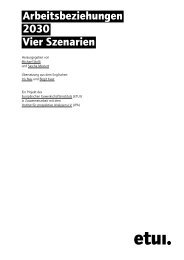Occupation and cancer - European Trade Union Institute (ETUI)
Occupation and cancer - European Trade Union Institute (ETUI)
Occupation and cancer - European Trade Union Institute (ETUI)
You also want an ePaper? Increase the reach of your titles
YUMPU automatically turns print PDFs into web optimized ePapers that Google loves.
Acta Oncol Downloaded from informahealthcare.com by 212.35.100.66 on 04/06/11<br />
For personal use only.<br />
706 E. Pukkala et al.<br />
lowest in engine operators (0.63, 0.42 0.90) <strong>and</strong><br />
forestry workers (Table 39).<br />
In women, the occupational groups with the<br />
highest SIRs were military personnel (1.57, 1.03<br />
2.30), dentists, journalists, physicians, administrators<br />
<strong>and</strong> artistic workers (Table 40). The SIR was<br />
lowest among fishermen (0.69, 0.50 0.92); followed<br />
by forestry workers, wood workers, gardeners <strong>and</strong><br />
farmers.<br />
The contrast between the highest <strong>and</strong> the lowest<br />
SIRs was somewhat stronger for lobular <strong>cancer</strong><br />
(around 10% of breast <strong>cancer</strong>; http://astra.can<br />
cer.fi/NOCCA/Incidence/breast-lobular), than for<br />
ductal <strong>cancer</strong> (around 80% of breast <strong>cancer</strong>; http://<br />
astra.<strong>cancer</strong>.fi/NOCCA/Incidence/breast-ductal).<br />
The highest SIR for the lobular type was 1.79 (1.39<br />
2.28) for journalists, followed by physicians (1.71,<br />
1.36 2.13), dentists (1.66, 1.22 2.20) <strong>and</strong> administrators<br />
(1.51, 1.34 1.71). The lowest SIRs were seen<br />
for engine operators (0.43, 0.24 0.72) <strong>and</strong> woodworkers<br />
(0.53, 0.39 0.71).<br />
Comment. Among men, the occupations with the<br />
highest incidence were characterised by shift- or<br />
night work. Shift work that involves night work<br />
(<strong>and</strong> thus circadian disruption) has been classified<br />
by the International Agency for Cancer Research as<br />
probably carcinogenic to humans, with the human<br />
evidence based on breast <strong>cancer</strong> research [96]. In the<br />
present study the results for women were less<br />
suggestive of an association with shift or night<br />
work. This could be related to the fact that for<br />
women, the most important non-genetic risk factors<br />
for breast <strong>cancer</strong> are hormonal factors, strongly<br />
connected with reproductive behaviour [97].<br />
Young age at first birth <strong>and</strong> an increasing number<br />
of births are associated with lowered risk. The<br />
/ 100 000<br />
100<br />
80<br />
60<br />
40<br />
20<br />
Denmark<br />
Finl<strong>and</strong><br />
Icel<strong>and</strong><br />
Norway<br />
Sweden<br />
Women<br />
0<br />
1945 1960 1975 1990 2005<br />
Figure 29. Age st<strong>and</strong>ardised (World) incidence rates for breast <strong>cancer</strong> 1943 2005, by country. Modified from NORDCAN [49].<br />
present results showed the highest SIRs in occupations<br />
that require high education <strong>and</strong> cause women<br />
to postpone their first childbirth. Other established<br />
risk factors for breast <strong>cancer</strong> include ionising radiation,<br />
lack of physical activity, high body mass index<br />
<strong>and</strong> alcohol consumption. These factors were not<br />
particularly reflected in the present results, except<br />
for a tendency for occupations with high levels of<br />
physical activity to have the lowest SIRs. The<br />
contrasts seen between occupations were considerably<br />
higher among men than women, which might<br />
indicate a stronger occupationally related aetiology<br />
among the men.<br />
Cervical <strong>cancer</strong><br />
Incidence of cervical <strong>cancer</strong> has decreased in<br />
all Nordic countries since the 1960s, except for in<br />
Norway where the decrease started in the mid 1970s<br />
(Figure 30). This can mainly be explained by the<br />
introduction of organised screening programmes.<br />
The lowest rate, in Finl<strong>and</strong>, has always been less<br />
than half of the highest rate, in Denmark.<br />
The highest SIRs were seen among beverage<br />
manufacture workers (SIR 2.01, 95% CI 1.51<br />
2.61), ‘‘other construction workers’’, waiters, tobacco<br />
manufacture workers, drivers <strong>and</strong> electrical<br />
workers. The SIRs were lowest among the dentists<br />
(0.48, 0.30 0.74), physicians, teachers, farmers<br />
<strong>and</strong> nurses (Table 41).<br />
Comment. Infection with oncogenic types of human<br />
papilloma virus (HPV) is the main cause of cervical<br />
<strong>cancer</strong> [98]. Tobacco has an independent role in<br />
cervical <strong>cancer</strong> carcinogenesis.<br />
In previous research, high rates have been found<br />
among cleaners, food preparation workers <strong>and</strong> wait-


